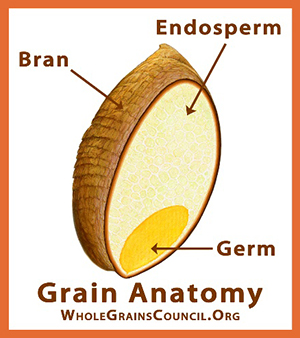Published:
March 27, 2019
For those of you with diabetes, you’ve likely been bombarded with blog posts, articles, friends and family telling you to cut out bread. The most common remarks I hear are: “bread is bad” or “bread will make you gain weight” or “wraps are better than bread.” We seem to be convinced that bread is an evil villain that will wage war on our body. Is bread truly as “bad” as everyone is making it out to be?
Let's Look at the Anatomy of a Grain

The bran is the outer layer of the grain or kernel. It holds antioxidants, B vitamins and most importantly FIBER.
The germ is the “embryo” of the grain. It contains B vitamins, protein, minerals and healthy fats.
The endosperm feeds the germ. It gives the plant energy to make roots and gather nutrients to grow. The endosperm is obviously the largest part of the grain and contains starchy carbohydrates, proteins and small amounts of vitamins and minerals.
Simple vs. Complex Carbohydrates
Simple carbohydrates, or refined grains, have the bran and germ removed, leaving only the endosperm. Therefore, foods like white bread, white rice, overly processed packaged products, sugary cereals and desserts have less fiber.
Complex carbohydrates, or whole grains, have the bran, germ and endosperm intact, keeping the fiber. Since they have more fiber, complex carbs digest more slowly and don’t raise blood sugars quickly. They also help keep you fuller, longer. Examples of complex carbohydrates: whole wheat bread, brown rice and lentil pasta.
What’s the Verdict?
When bread and wraps are made with whole grains, they are nutritionally equivalent. One slice of bread has 15 grams of carbohydrate; likewise, one 6” wrap has 15 grams of carbohydrate. This means wraps are no better for us than bread.
So don’t simply avoid bread just because it’s bread. Instead, look for foods with whole grains, whether that be bread, wraps, crackers, cereals, or pastas. The quality of the grain and the portion size are more important than the form of the grain. If you had to choose, a slice of whole wheat bread will actually be a more nutritious choice than a white flour tortilla.
Keep in mind that while whole grains are better than refined grains, try to avoid labeling foods as “good” or “bad.” Using that kind of language makes you feel like you’re doing “badly” or “poorly” for eating an occasional cookie. No food is good or bad. Some are simply more nutritious than others. So, remember you can eat anything you want, but in moderation.